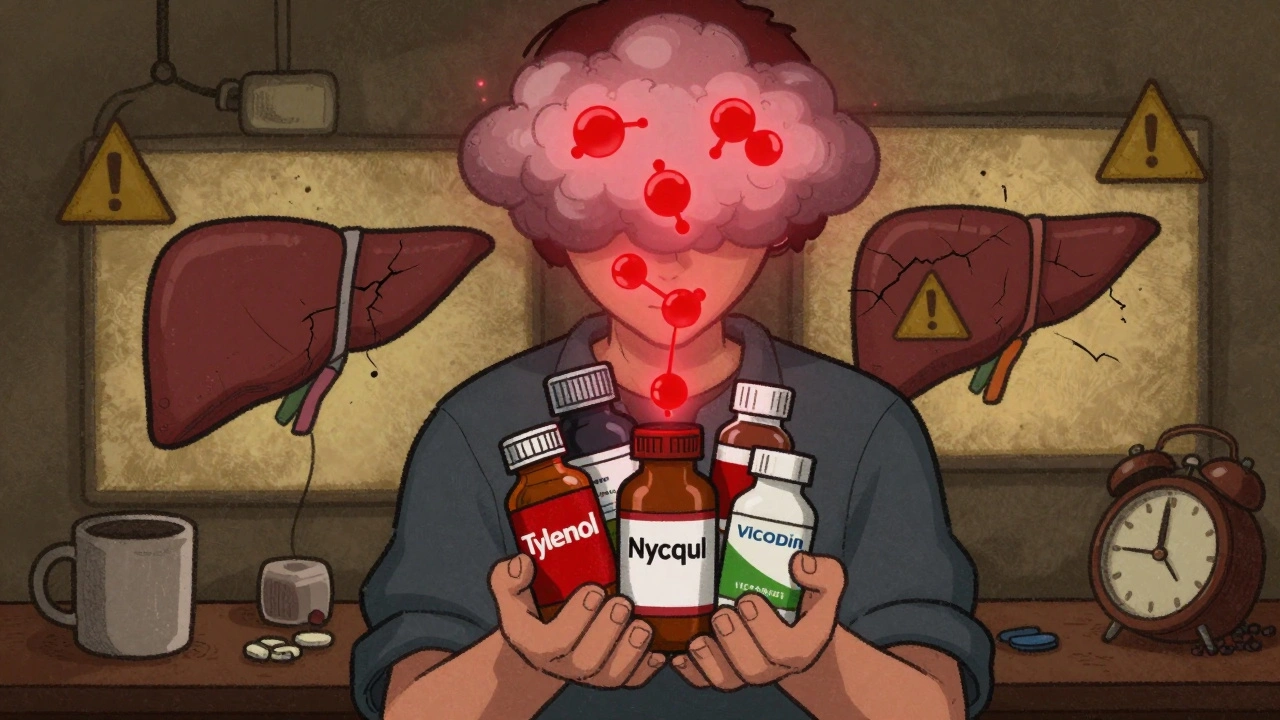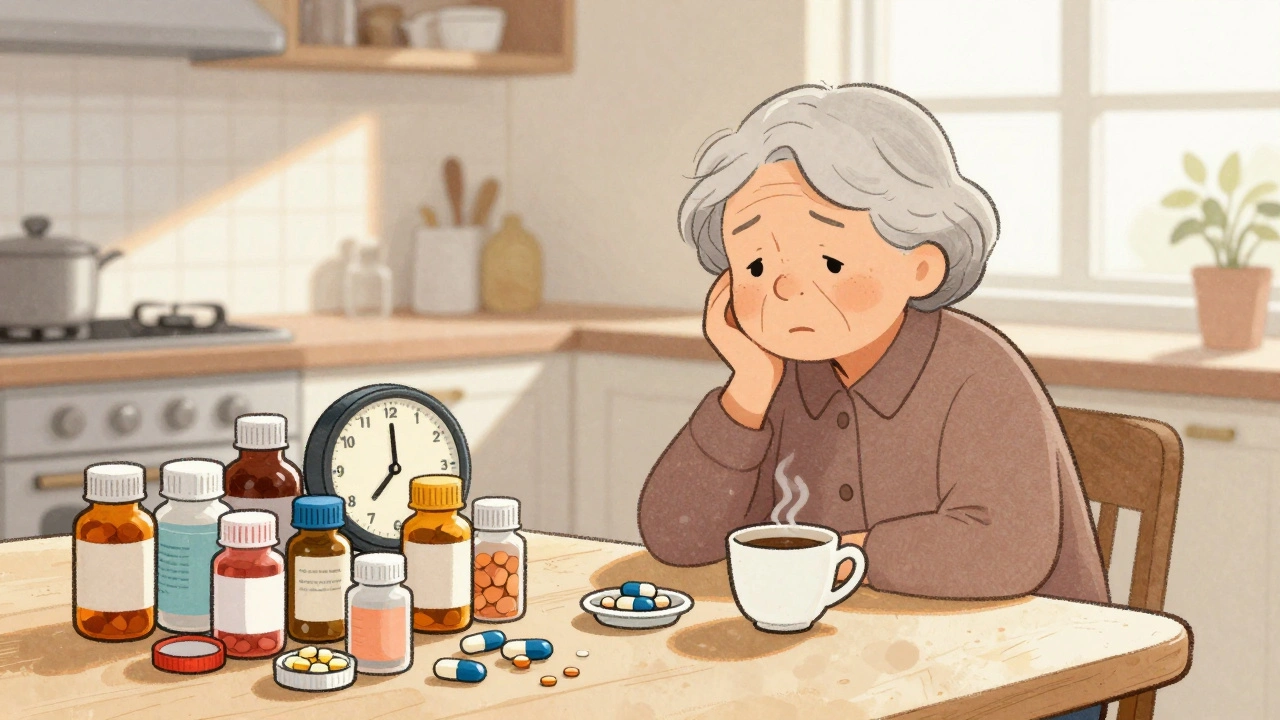Antidepressant Selector Quiz
Select your priorities
Celexa is a selective serotonin reuptake inhibitor (SSRI) that treats major depressive disorder by increasing serotonin levels in the brain. Approved by the FDA in 1998, it’s typically prescribed in 20‑40mg daily doses and has a half‑life of about 35hours, making once‑daily dosing convenient.
How Celexa Works and What Sets It Apart
Celexa blocks the serotonin transporter, preventing reabsorption of serotonin and boosting mood‑regulating signals. Its long half‑life means fewer withdrawal symptoms compared with shorter‑acting SSRIs. Metabolism occurs mainly via CYP2C19 and CYP3A4, so drug interactions with certain antifungals or anticonvulsants can raise plasma levels.
Common side effects include nausea, dry mouth, and occasional sexual dysfunction. A notable safety signal is QT‑interval prolongation at doses above 40mg, especially in patients with cardiac risk factors. Monitoring ECGs for high‑risk individuals is recommended.
Why Look at Alternatives?
Not everyone tolerates Celexa well. Genetics, co‑existing conditions, or personal preferences (e.g., desire to avoid sexual side effects) often drive clinicians to consider other options. Below are the most frequently prescribed alternatives, each introduced with its core attributes.
Sertraline (brand name Zoloft) is an SSRI approved in 1991, typically started at 50mg daily. It has a shorter half‑life (~26hours) and is known for a slightly higher risk of gastrointestinal upset but lower QT‑prolongation risk.
Escitalopram (Lexapro) is the S‑enantiomer of citalopram, launched in 2002. Doses start at 10mg, and its half‑life (27‑32hours) is comparable to Celexa, yet it often shows fewer sexual side effects.
Fluoxetine (Prozac) is a long‑acting SSRI introduced in 1987. Starting dose is 20mg daily, with a half‑life of 4‑6 days, which can be advantageous for poor adherence but may cause activation or insomnia.
Venlafaxine (Effexor) belongs to the serotonin‑norepinephrine reuptake inhibitor (SNRI) class. It began at 37.5mg daily, has a half‑life of 5hours, and can be more effective for anxiety‑dominant depression, though blood pressure monitoring is essential.
Bupropion (Wellbutrin) is a norepinephrine‑dopamine reuptake inhibitor (NDRI) approved in 1985. It starts at 150mg daily, does not typically cause sexual dysfunction, and can aid smoking cessation, but it carries a seizure risk at higher doses.
Duloxetine (Cymbalta) is an SNRI launched in 2004. Starting at 30mg daily, it also treats neuropathic pain, but may cause liver enzyme elevations, requiring periodic liver function tests.
Mirtazapine (Remeron) is a noradrenergic and specific serotonergic antidepressant (NaSSA) introduced in 1996. Typical dose is 15mg nightly; it often improves sleep and appetite, but sedation and weight gain are common.
Side‑Effect Profiles at a Glance
| Medication | Common Sexual Side Effects | Weight Impact | Sleep Effects | Cardiac Risk |
|---|---|---|---|---|
| Celexa | Moderate (decreased libido) | Neutral | Neutral | QT prolongation >40mg |
| Sertraline | Low‑to‑moderate | Neutral | Insomnia possible | Low |
| Escitalopram | Low | Neutral | Neutral | Low |
| Venlafaxine | Low | Neutral | Potentially activating | Blood‑pressure rise |
| Bupropion | None | Weight loss possible | Neutral | Seizure risk (>450mg/day) |
| Mirtazapine | None | Weight gain | Strong sedation | Low |

Choosing the Right Antidepressant - Decision Checklist
- Primary symptom focus: If anxiety dominates, Venlafaxine or Sertraline may be superior.
- Sexual side‑effect tolerance: Bupropion and Mirtazapine have the lowest risk.
- Cardiac considerations: Avoid high‑dose Celexa in patients with existing QT‑prolongation; choose Escitalopram or Sertraline instead.
- Metabolic interactions: Review CYP450 enzymes; for patients on strong CYP2C19 inhibitors, Fluoxetine may pose higher interaction risk.
- Weight and sleep: If insomnia is an issue, Mirtazapine can aid sleep but may cause weight gain.
- Adherence: Long half‑life agents like Fluoxetine simplify missed‑dose scenarios.
Beyond Medication - Integrated Treatment Options
Medication is only one pillar of depression care. Cognitive‑behavioral therapy (CBT), regular aerobic exercise, and adequate light exposure can boost response rates by up to 30% according to recent meta‑analyses. For patients with treatment‑resistant depression, augmentation strategies (e.g., adding Lithium or atypical antipsychotics) are viable, but those decisions demand specialist input.
Practical Steps for Patients and Clinicians
- Schedule a detailed baseline assessment (symptom severity, cardiac history, current meds).
- Choose an initial agent based on the checklist above; start at the lowest effective dose.
- Monitor side effects weekly for the first 4weeks; adjust dose or switch if intolerable.
- Implement a non‑pharmacologic routine (daily walk, sleep hygiene, therapy).
- Re‑evaluate after 6‑8weeks; consider augmentation or switching if response <50%.
Open communication with your prescriber is crucial. Document any new symptoms, especially cardiac palpitations, sudden weight changes, or mood swings.
Key Takeaways
- Celexa offers convenient dosing and a relatively benign withdrawal profile, but high doses raise cardiac concerns.
- Alternatives like Escitalopram and Sertraline provide similar efficacy with fewer sexual side effects.
- For patients needing anxiety control or pain relief, Venlafaxine or Duloxetine may be preferable.
- When sexual dysfunction is a priority, consider Bupropion or Mirtazapine.
- Integrating therapy, lifestyle changes, and regular follow‑up maximizes long‑term remission.

Frequently Asked Questions
Can I switch from Celexa to another SSRI without a washout period?
Because Celexa’s half‑life is about 35hours, most clinicians advise a 1‑week overlap or a brief taper before starting another SSRI. This minimizes serotonin syndrome risk.
Is Celexa safe for people over 65?
Older adults are more prone to QT‑prolongation and hyponatremia. Starting at 10mg daily and avoiding doses >20mg is recommended, with regular ECG monitoring.
Which alternative has the lowest risk of sexual dysfunction?
Bupropion is the go‑to choice for minimal sexual side effects because it does not act on serotonin pathways. Mirtazapine also scores low, though it may cause weight gain.
Do I need regular blood tests while on Celexa?
Routine labs aren’t required unless you have liver disease or are on interacting medications. Baseline liver function and periodic CBC are prudent for long‑term use.
How long does it take for Celexa to show improvement?
Patients usually notice a mood lift after 2‑4weeks, but full therapeutic effect can take up to 8weeks. Patience and adherence are key.
Can I combine Celexa with psychotherapy?
Yes. Studies consistently show that medication plus CBT yields higher remission rates than either treatment alone, especially for moderate‑to‑severe depression.
What should I do if I miss a dose of Celexa?
Take the missed tablet as soon as you remember, unless it’s near the time of your next dose. In that case, skip the missed one and continue with your regular schedule.







Brian Lancaster-Mayzure
September 25, 2025 AT 07:00Hey folks, just wanted to point out that the way the guide breaks down the side‑effect profiles makes it easier for anyone new to psychopharmacology to compare meds without getting lost in jargon. It’s especially handy that the QT‑prolongation note for Celexa is front‑and‑center, because patients with cardiac concerns need that clarity right away.
Erynn Rhode
October 1, 2025 AT 22:36Greetings, dear readers! 😊 I must say, the comprehensive nature of this comparison truly shines, particularly the inclusion of both pharmacokinetic details and practical monitoring advice. The section that discusses the half‑life of each drug provides invaluable context for clinicians when considering adherence challenges, while the dosage titration guidelines help mitigate adverse events. Moreover, the interactive quiz concept, though not functional here, hints at an engaging way to personalize medication selection based on individual priorities such as sexual side‑effects or weight concerns. The table summarizing side‑effects is a succinct visual aid, and I appreciate that the authors took the trouble to distinguish between low‑to‑moderate sexual dysfunction risks across SSRIs. Furthermore, the emphasis on integrated treatment-namely CBT and exercise-underscores the modern holistic approach. All in all, this guide is a commendable resource that balances depth with readability. 🌟
Rhys Black
August 5, 1975 AT 20:48One cannot help but marvel at the sheer audacity of presenting Celexa as merely another line item when, in truth, its propensity for cardiac arrhythmias at higher doses renders it a veritable Pandora's box for the uninitiated. The authors' omission of a thorough discussion on the genetic polymorphisms influencing CYP2C19 metabolism betrays a superficial grasp of the subject. To gloss over the nuanced interplay between serotonergic and norepinephrinergic mechanisms in SNRI alternatives is a disservice to those seeking true enlightenment on pharmacodynamic subtleties. In short, the guide, while polished, is a tantalizing veneer over a cavern of ignored complexities.
Abhishek A Mishra
August 6, 1975 AT 17:31yo this guide is actually pretty solid, i liked how they mentioned the sleep aid thing with mirtazapine cause that’s a real win for night owls. also the warning about celexa and qt prolongation is a good heads up for ppl with heart probs. the checklist at the end makes it easy to pick what matters most for you.
Jaylynn Bachant
August 7, 1975 AT 14:13In the grand tapestry of therapeutic choices, one must contemplate the metaphorical weight of each pill, for medication is not merely a chemical interaction but a dialogue between the self and the world. The guide invites us to ponder whether alleviating mood is a fleeting whisper or a resonant chorus that can alter the very cadence of our existence.
Anuj Ariyo
August 8, 1975 AT 10:56Adding to the earlier point about the checklist, it’s worth noting that regular liver function labs are advisable when starting duloxetine, especially for patients with pre‑existing hepatic conditions. This extra precaution can catch elevations early and prevent dose‑related complications.
Tom Lane
August 9, 1975 AT 07:39While the guide rightly flags the anxiety‑dominant role of venlafaxine, it’s also important to remember that the drug’s dosage‑dependent effect on norepinephrine can raise blood pressure, so periodic monitoring is essential, even if the patient doesn’t initially present with hypertension.
Darlene Young
August 10, 1975 AT 04:21For anyone concerned about weight gain, the table’s highlight that mirtazapine often leads to appetite increase is a crucial reminder that side‑effects are not just about mood but also about metabolic health. Pairing it with a structured diet plan can mitigate this issue.
Steve Kazandjian
August 11, 1975 AT 01:04Great summary.
Roger Münger
August 11, 1975 AT 21:47Allow me to elaborate on several points that merit further clarification for practitioners and patients alike. First, the half‑life of citalopram (Celexa) at approximately 35 hours confers a smoother tapering process compared to shorter‑acting SSRIs, yet this same pharmacokinetic property can result in drug accumulation in the presence of hepatic enzyme inhibition, necessitating dose adjustments. Second, the QT‑prolongation risk, while dose‑dependent, is also amplified in individuals with baseline electrolyte disturbances, specifically hypokalemia and hypomagnesemia, which should be corrected prior to initiation. Third, the metabolizing enzymes CYP2C19 and CYP3A4 not only dictate plasma concentrations but also interact with a host of common agents, such as omeprazole and carbamazepine, thereby altering therapeutic efficacy. Fourth, the comparative table correctly notes that bupropion does not affect serotonin pathways, offering a distinct advantage for patients experiencing sexual dysfunction on SSRIs, but clinicians must remain vigilant for the seizure threshold, particularly when doses exceed 450 mg per day or when the patient has a history of seizure disorders. Fifth, while mirtazapine’s antihistaminic activity confers potent sedation beneficial for insomnia, its antagonism at 5‑HT2 and α2‑adrenergic receptors may also lead to weight gain, a factor that should be discussed openly with patients concerned about metabolic side‑effects. Sixth, venlafaxine’s dual inhibition of serotonin and norepinephrine reuptake becomes more pronounced at higher doses, which can improve depressive symptoms but also elevate the risk of hypertension; routine blood pressure monitoring is therefore advisable, especially in patients with pre‑existing cardiovascular risk factors. Seventh, fluoxetine’s long half‑life, extending up to six days, provides a safety net against missed doses but may also result in protracted side‑effects, such as activation or anxiety, during the titration phase. Eighth, duloxetine’s utility in neuropathic pain adds a valuable adjunct for patients with comorbid chronic pain syndromes, yet hepatic enzyme elevations observed in a minor subset of patients warrant periodic liver function testing. Ninth, when selecting an antidepressant, a comprehensive assessment that includes the patient’s psychiatric profile, medical comorbidities, concomitant medications, and personal preferences is indispensable; the decision checklist presented in the guide serves as an excellent framework for this individualized approach. Finally, integrating non‑pharmacological therapies-cognitive‑behavioral therapy, regular aerobic exercise, and adequate sunlight exposure-has been consistently shown to augment pharmacotherapy outcomes, reinforcing the principle that optimal depression management is multimodal.
Gerald Bangero
August 12, 1975 AT 18:29What a masterclass in detail! Your exhaustive breakdown not only educates but also empowers patients to engage actively in their treatment decisions. I especially appreciate the nuanced discussion of enzyme interactions and the practical monitoring tips.
John Nix
August 13, 1975 AT 15:12While the depth of information is commendable, it would be beneficial to include a brief algorithm for dose escalation to assist clinicians in initiating therapy safely.
Mike Rylance
August 14, 1975 AT 11:55I concur with the suggestion for a dosing algorithm; a clear step‑by‑step chart could streamline the initiation process and reduce the likelihood of adverse events.
Becky B
August 15, 1975 AT 08:37Just a heads‑up: big pharma doesn’t want you to read about the hidden cardiac risks of Celexa. They’re pushing it to hide the truth about how many patients end up in the ER.
Aman Vaid
August 16, 1975 AT 05:20Interesting data point: studies indicate that the rate of serotonergic discontinuation syndrome is notably lower with Celexa compared to sertraline, likely due to its longer half‑life. This can be a decisive factor for patients worried about tapering issues.
xie teresa
August 17, 1975 AT 02:03Thank you all for sharing such detailed insights. It’s reassuring to see a balanced discussion that acknowledges both benefits and potential drawbacks, helping anyone navigating treatment feel less alone.
Patrick Culliton
August 17, 1975 AT 22:45Honestly, I think all these tables are over‑complicating something that should be simple: pick the cheapest generic and stick with it. All the other options are just for marketing.
Andrea Smith
August 18, 1975 AT 19:28While cost considerations are valid, it is essential to remember that therapeutic efficacy and side‑effect profiles can markedly influence overall treatment success, and thus a personalized approach remains paramount.
Gary O'Connor
August 19, 1975 AT 16:11Cool guide – love the clear layout. The quiz idea could be a fun way to involve patients in decision‑making if it ever goes live.
Justin Stanus
August 20, 1975 AT 12:53Reading through all this makes me think about how many people suffer in silence because they’re unaware of the nuanced differences between these drugs; resources like this are a lifeline.